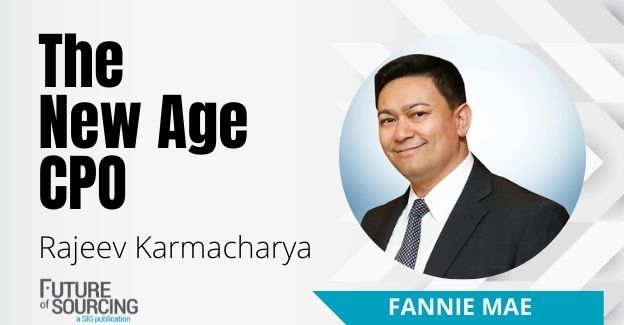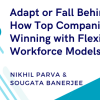In this series, Future of Sourcing is talking to practitioners, technologists and executives to get their insights and expertise on navigating current and future challenges impacting sourcing, procurement, risk and supply chain professionals. After the past two years, there’s a lot that we can learn from each other.
To be considered for this series or to nominate someone to be featured, please reach out to Stacy Mendoza, Managing Editor.
Rajeev Karmacharya is Head of the Strategic Sourcing and Category Management group in Fannie Mae. He leads a team of category management, sourcing/contracting and supplier operations professionals managing $4.5+ billion in external spend.
Rajeev and his team are committed to delivering tangible value to their business stakeholders by bringing supply market expertise and helping them achieve their business objectives at market competitive rates. We talk to Rajeev about navigating the recent supply chain disruptions, how procurement professionals are uniquely suited to overcome current market volatility, and ways that procurement can creatively combat inflation.
1. Your procurement team at Fannie Mae was recognized for its procurement transformation. What technologies have helped your team navigate the recent supply chain disruptions and what are some of the outcomes?
It is certainly an honor to be recognized for our procurement transformation. I am proud of our team’s accomplishments and the progress we have made in a short period of time. We have transitioned from a compliance-focused function to a value-driven model, with greater emphasis on understanding business objectives so we can source optimal suppliers and solutions that meet business requirements while managing risks.
This has been possible due to collaborative partnership with our stakeholders and a more proactive approach to sourcing and purchasing decisions. We have implemented a structured strategic sourcing methodology that allows our team to deliver results consistently. SIG University’s Certified Sourcing Professional certification program has been instrumental in that regard by helping us establish a common framework and institutionalize a holistic approach to sourcing.
Technology solutions have also been a key enabler of our transformation success. Since we are primarily in the indirect procurement space, the impact of recent supply chain disruptions has been manageable. Our investment in technology has certainly paid off. With an integrated source-to-pay and CLM solution, we identified potential areas of concern quickly as we have good visibility into our contractual obligations. We also leveraged contract analytics tools to identify exposure to rising inflationary pressures and develop mitigation plans accordingly.
In addition, having the right technology and process infrastructure enabled us to proactively assess potential supplier exits and efficiently seek alternatives, thus building supply chain resiliency.
2. What do you think is the biggest obstacle contributing to the supply chain chaos in 2022 and what can industry professionals do to overcome it?
2022 has been a challenging year so far due to a multitude of factors. First, we still have lots of catch-up to do with COVID-related supply constraints and continuing shutdowns in parts of the world. We have all heard about how the chip shortage is impacting supply across several categories, but that is just one example.
The supply crunch has been relatively broad and impacts many categories. Second, labor shortage, talent availability with the “great resignation” phenomenon and increasing labor costs are also a concern. The war in Ukraine has also impacted supply and energy prices, which has a cascading impact on costs across the supply chain. So, shifting market conditions with changing cost structures and supply shocks – whether that has to do with materials, energy or labor – are fundamentally changing the supply market dynamic.
As a result, supply chain and procurement professionals must be creative in terms of how we bring value and focus on price reduction, as well as specification rationalization and demand management levers. This is where greater supplier partnership and joint innovation plays a key role.
With continued pricing pressures, it is important to understand key drivers of costs and find ways to mitigate both short-term price shocks and longer-term pricing trends. Should-cost modeling becomes even more important in that context. We must take a holistic and analytical approach to cost management – understanding key cost drivers and exploring category management and demand management levers to rationalize requirements. But that may not be enough. We must also be working with our internal business stakeholders to ensure awareness, so they are prepared for potential cost increases and committed to partner with procurement and suppliers to drive cost management opportunities.
Besides costs, supply chain resiliency has much greater significance given the current challenges. So, it is imperative that supply chain and procurement professionals are proactively addressing supply concerns and ensuring that viable contingency plans are in place. Even though there are benefits to rationalizing supplier base, these are times when we may want to consider expanding supplier portfolio to allow for added capacity and contingency.
3. Buying is different in an inflationary market. How can procurement respond to inflation?
The inflationary environment is obviously challenging from a procurement perspective. However, I think challenging times are when procurement truly has an opportunity to shine.
I referenced should-cost models earlier. As I alluded to in the earlier question, it is important for procurement professionals to have a good understanding of cost structure of products and services they are buying and potential ways to mitigate costs – whether that means challenging requirements, managing demand or proactively seeking substitutes.
Some examples include: are we increasing costs for our suppliers by seeking extraneous services that do not really add value? For hardware/software support/maintenance, do we need platinum-level maintenance, or is a lower level of support acceptable? Similarly, could we repurpose/harvest unused software licenses? Do we have solutions that have similar capabilities and if so, could we rationalize offerings?
On a more tactical level, with regard to existing deals, we need to be thoughtful about strategically extending contract terms to retain favorable pricing and leverage pricing tiers to build flexibility. We need to seek out opportunities to mitigate upward pressures in pricing by rethinking the supplier base and how services get delivered. For example, in the case of contingent labor, are there opportunities to leverage a remote work model and diversify how we are hiring resources? Removing geographic constraints can not only help mitigate cost concerns, but also brings a larger talent pool to source from.
While inflationary times are challenging, procurement professionals have a lot of resources in their toolkit and can help their business stakeholders successfully navigate these turbulent times.








